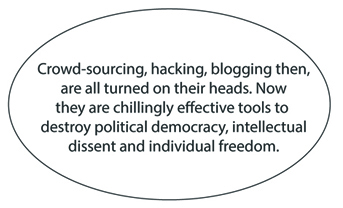2 Keen on the internet
You start by looking at a short argument by Andrew Keen, an author and former internet entrepreneur. Keen was one of the first to argue that the internet is not necessarily a force for good. Here he is with a characteristically combative contribution to the blog of the OU/BBC Virtual Revolution series:
In China, Russia and Iran, the Internet has become a disturbingly effective set of technological tools for maintaining the power of the old elites. In Russia, for example, Putin’s cronies just financed an online witch hunt against a single Georgian activist which was so effective that it brought down not only Twitter, but also Facebook. In Iran, the increasingly powerful regime now sponsors religious workshops in the holy city of Qom which offer courses for seminarians in how to blog about the Iranian revolution. In China, the regime pays ‘distributed citizens’ to ‘engage in conversation’ with dissidents on the Internet. Crowd-sourcing, hacking, blogging then, are all turned on their heads. Now they are chillingly effective tools to destroy political democracy, intellectual dissent and individual freedom.
The aim of the first activity is to analyse Keen’s sceptical evaluation of the internet by constructing an argument map for it. You will be provided with guidance throughout the analysis. The guidance is based on the three steps of the recipe in Section 1.
Activity 1 In China, Russia and Iran …
According to the first step of the recipe, you should start by identifying the main claim. If you are looking at a paragraph of text, you can often find it at the beginning or the end (and sometimes in the heading or subheading).
A good indication that you have found the main claim is that the claim you have identified does not support any other claims in the paragraph. If a claim supports another claim, it can’t itself be the main claim. Usually, but not always, there will also be clues such as the use of connecting words and phrases including ‘therefore’, ‘in conclusion’ and ‘consequently’. The claim can consist of one or more sentences.
Now try to identify the sentences in Keen’s argument that express its main claim.
Discussion
The main claim is ‘Crowd-sourcing, hacking, blogging then, are all turned on their heads. Now they are chillingly effective tools to destroy political democracy, intellectual dissent and individual freedom.’ Note the use of the word ‘then’ to signal that a conclusion is being drawn and how the second sentence explains what is meant by the first sentence. Place this main claim on your argument map (Figure 3).
Next, apply the repeat step of the recipe by proceeding to the next level. Identify any further claims and add them to the argument map using the appropriate relationship.
Now apply the second step of the recipe. Having identified the main claim, locate a statement which directly supports (or opposes) this main claim.
Discussion
You can now update your map accordingly (Figure 4).
The statement in question is ‘In China, Russia and Iran, the Internet has become a disturbingly effective set of technological tools for maintaining the power of the old elites.’ This statement is more specific than the main claim. For that reason, this statement itself is not the main claim. The main claim makes a general claim about ‘Crowd-sourcing, hacking, blogging’, whereas this claim focuses on China, Russia and Iran.
There are three statements starting with ‘In Russia’, ‘In Iran’ and ‘In China’. When taken together, do they support the claim at the previous level?
Discussion
For these three statements you need to decide whether they form a group or are independent of each other. In this case, they are grouped. Individually, they do not support the claim at the previous level that ‘In China, Russia and Iran, the Internet has become a disturbingly effective set of technological tools for maintaining the power of the old elites.’
To signal that these three statements support the previous statement as a group, on the argument map, connect them to the previous statement with a single line labelled ‘support’ (Figure 4).
This concludes your construction of the argument map for Keen’s argument. Even though it dates from 2009, it still feels highly contemporary in 2019 (when this course was written). Discussion about the negative impact of social media on both democratic and authoritarian societies is still very much in the public eye.




